GST Input Tax Credit for Advertisement Expenses
VerifiedAdded on 2020/04/07
|15
|2018
|32
AI Summary
The assignment explores the eligibility of Big Bank to claim an input tax credit for advertising expenditures under GST regulations. It examines relevant legislation (GSTR 2006/13), considers the purpose of acquisitions, and analyzes whether the expenditure qualifies as a creditable acquisition. The discussion utilizes legal references and rulings to support the analysis and reach a conclusion on Big Bank's eligibility for input tax credit.
Contribute Materials
Your contribution can guide someone’s learning journey. Share your
documents today.
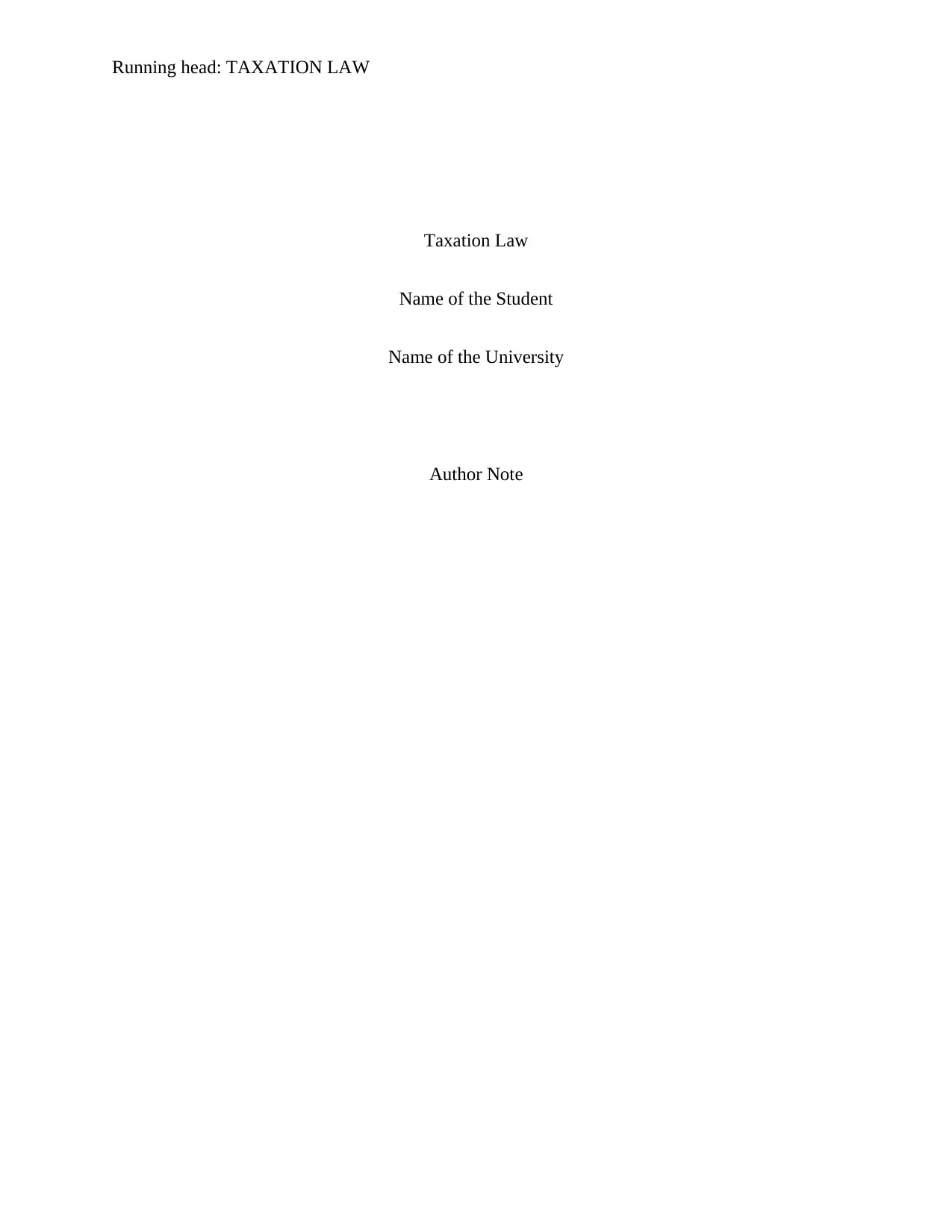
Running head: TAXATION LAW
Taxation Law
Name of the Student
Name of the University
Author Note
Taxation Law
Name of the Student
Name of the University
Author Note
Secure Best Marks with AI Grader
Need help grading? Try our AI Grader for instant feedback on your assignments.
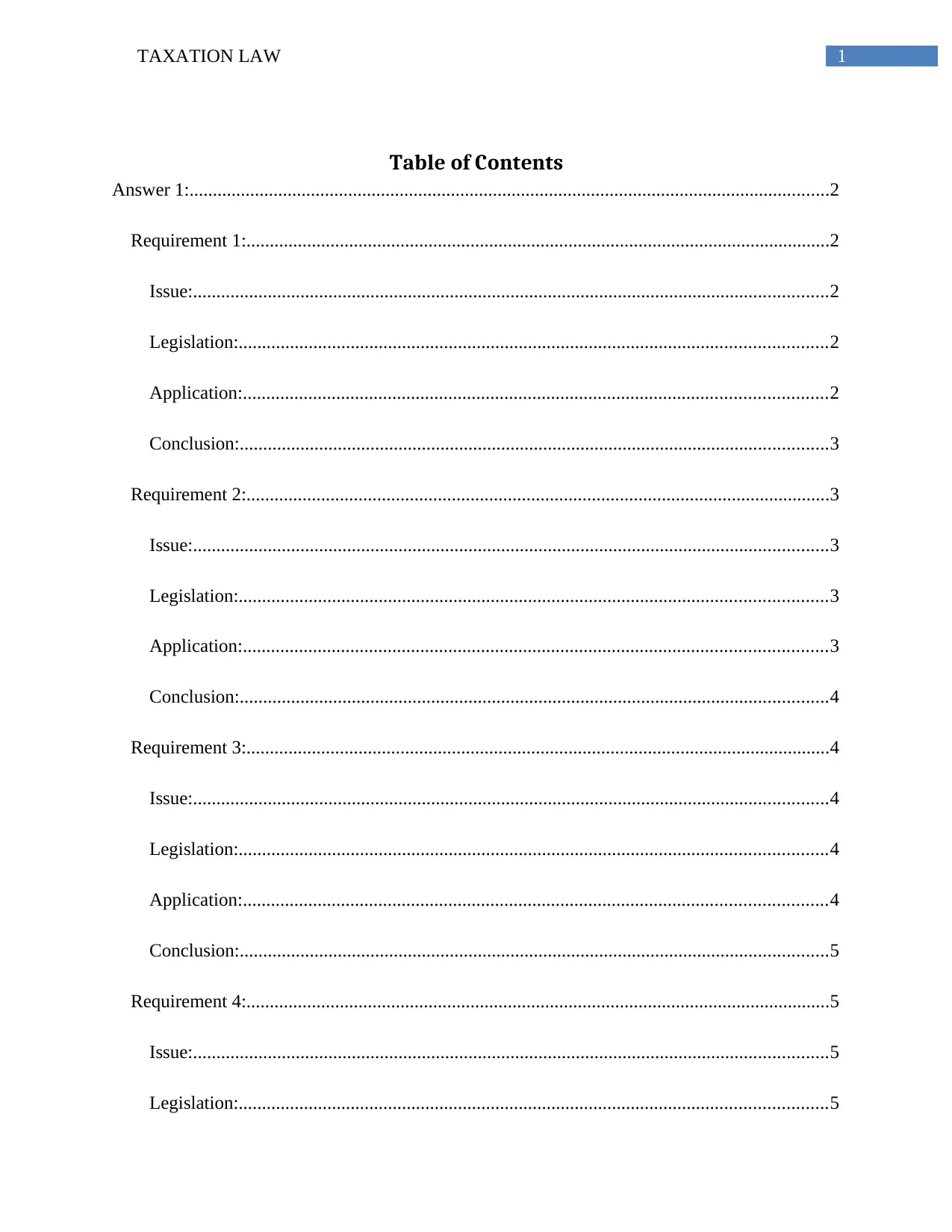
1TAXATION LAW
Table of Contents
Answer 1:.........................................................................................................................................2
Requirement 1:.............................................................................................................................2
Issue:........................................................................................................................................2
Legislation:..............................................................................................................................2
Application:.............................................................................................................................2
Conclusion:..............................................................................................................................3
Requirement 2:.............................................................................................................................3
Issue:........................................................................................................................................3
Legislation:..............................................................................................................................3
Application:.............................................................................................................................3
Conclusion:..............................................................................................................................4
Requirement 3:.............................................................................................................................4
Issue:........................................................................................................................................4
Legislation:..............................................................................................................................4
Application:.............................................................................................................................4
Conclusion:..............................................................................................................................5
Requirement 4:.............................................................................................................................5
Issue:........................................................................................................................................5
Legislation:..............................................................................................................................5
Table of Contents
Answer 1:.........................................................................................................................................2
Requirement 1:.............................................................................................................................2
Issue:........................................................................................................................................2
Legislation:..............................................................................................................................2
Application:.............................................................................................................................2
Conclusion:..............................................................................................................................3
Requirement 2:.............................................................................................................................3
Issue:........................................................................................................................................3
Legislation:..............................................................................................................................3
Application:.............................................................................................................................3
Conclusion:..............................................................................................................................4
Requirement 3:.............................................................................................................................4
Issue:........................................................................................................................................4
Legislation:..............................................................................................................................4
Application:.............................................................................................................................4
Conclusion:..............................................................................................................................5
Requirement 4:.............................................................................................................................5
Issue:........................................................................................................................................5
Legislation:..............................................................................................................................5
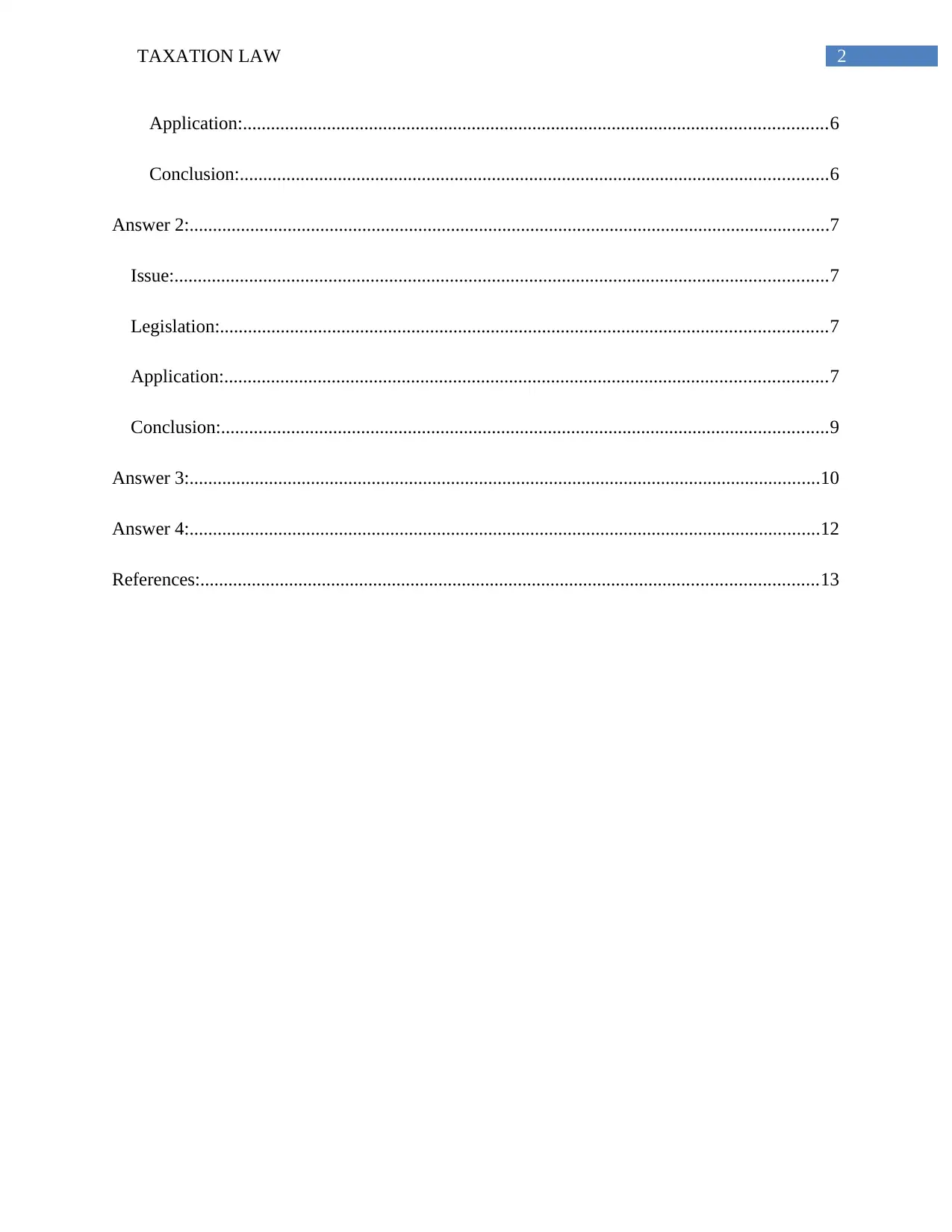
2TAXATION LAW
Application:.............................................................................................................................6
Conclusion:..............................................................................................................................6
Answer 2:.........................................................................................................................................7
Issue:............................................................................................................................................7
Legislation:..................................................................................................................................7
Application:.................................................................................................................................7
Conclusion:..................................................................................................................................9
Answer 3:.......................................................................................................................................10
Answer 4:.......................................................................................................................................12
References:....................................................................................................................................13
Application:.............................................................................................................................6
Conclusion:..............................................................................................................................6
Answer 2:.........................................................................................................................................7
Issue:............................................................................................................................................7
Legislation:..................................................................................................................................7
Application:.................................................................................................................................7
Conclusion:..................................................................................................................................9
Answer 3:.......................................................................................................................................10
Answer 4:.......................................................................................................................................12
References:....................................................................................................................................13
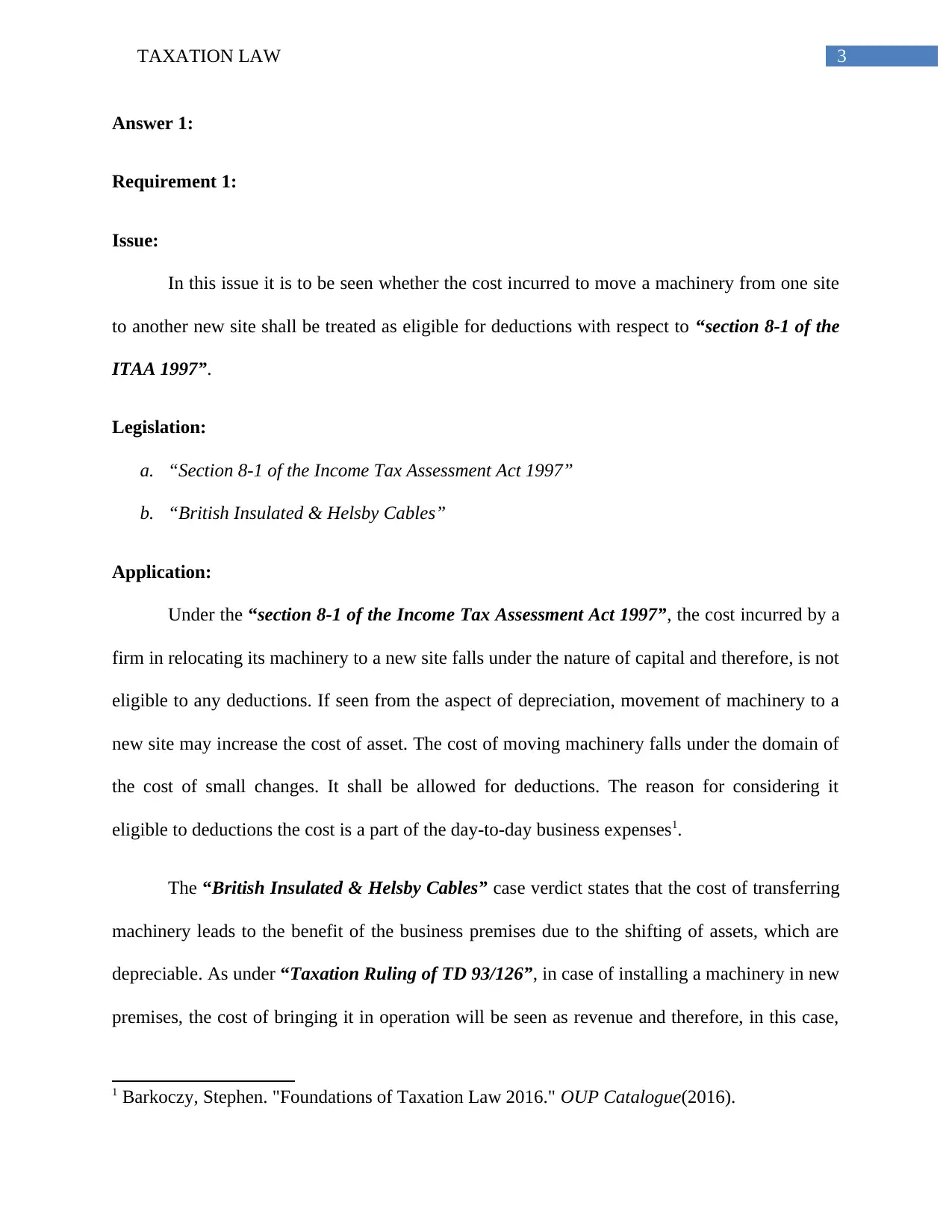
3TAXATION LAW
Answer 1:
Requirement 1:
Issue:
In this issue it is to be seen whether the cost incurred to move a machinery from one site
to another new site shall be treated as eligible for deductions with respect to “section 8-1 of the
ITAA 1997”.
Legislation:
a. “Section 8-1 of the Income Tax Assessment Act 1997”
b. “British Insulated & Helsby Cables”
Application:
Under the “section 8-1 of the Income Tax Assessment Act 1997”, the cost incurred by a
firm in relocating its machinery to a new site falls under the nature of capital and therefore, is not
eligible to any deductions. If seen from the aspect of depreciation, movement of machinery to a
new site may increase the cost of asset. The cost of moving machinery falls under the domain of
the cost of small changes. It shall be allowed for deductions. The reason for considering it
eligible to deductions the cost is a part of the day-to-day business expenses1.
The “British Insulated & Helsby Cables” case verdict states that the cost of transferring
machinery leads to the benefit of the business premises due to the shifting of assets, which are
depreciable. As under “Taxation Ruling of TD 93/126”, in case of installing a machinery in new
premises, the cost of bringing it in operation will be seen as revenue and therefore, in this case,
1 Barkoczy, Stephen. "Foundations of Taxation Law 2016." OUP Catalogue(2016).
Answer 1:
Requirement 1:
Issue:
In this issue it is to be seen whether the cost incurred to move a machinery from one site
to another new site shall be treated as eligible for deductions with respect to “section 8-1 of the
ITAA 1997”.
Legislation:
a. “Section 8-1 of the Income Tax Assessment Act 1997”
b. “British Insulated & Helsby Cables”
Application:
Under the “section 8-1 of the Income Tax Assessment Act 1997”, the cost incurred by a
firm in relocating its machinery to a new site falls under the nature of capital and therefore, is not
eligible to any deductions. If seen from the aspect of depreciation, movement of machinery to a
new site may increase the cost of asset. The cost of moving machinery falls under the domain of
the cost of small changes. It shall be allowed for deductions. The reason for considering it
eligible to deductions the cost is a part of the day-to-day business expenses1.
The “British Insulated & Helsby Cables” case verdict states that the cost of transferring
machinery leads to the benefit of the business premises due to the shifting of assets, which are
depreciable. As under “Taxation Ruling of TD 93/126”, in case of installing a machinery in new
premises, the cost of bringing it in operation will be seen as revenue and therefore, in this case,
1 Barkoczy, Stephen. "Foundations of Taxation Law 2016." OUP Catalogue(2016).
Secure Best Marks with AI Grader
Need help grading? Try our AI Grader for instant feedback on your assignments.
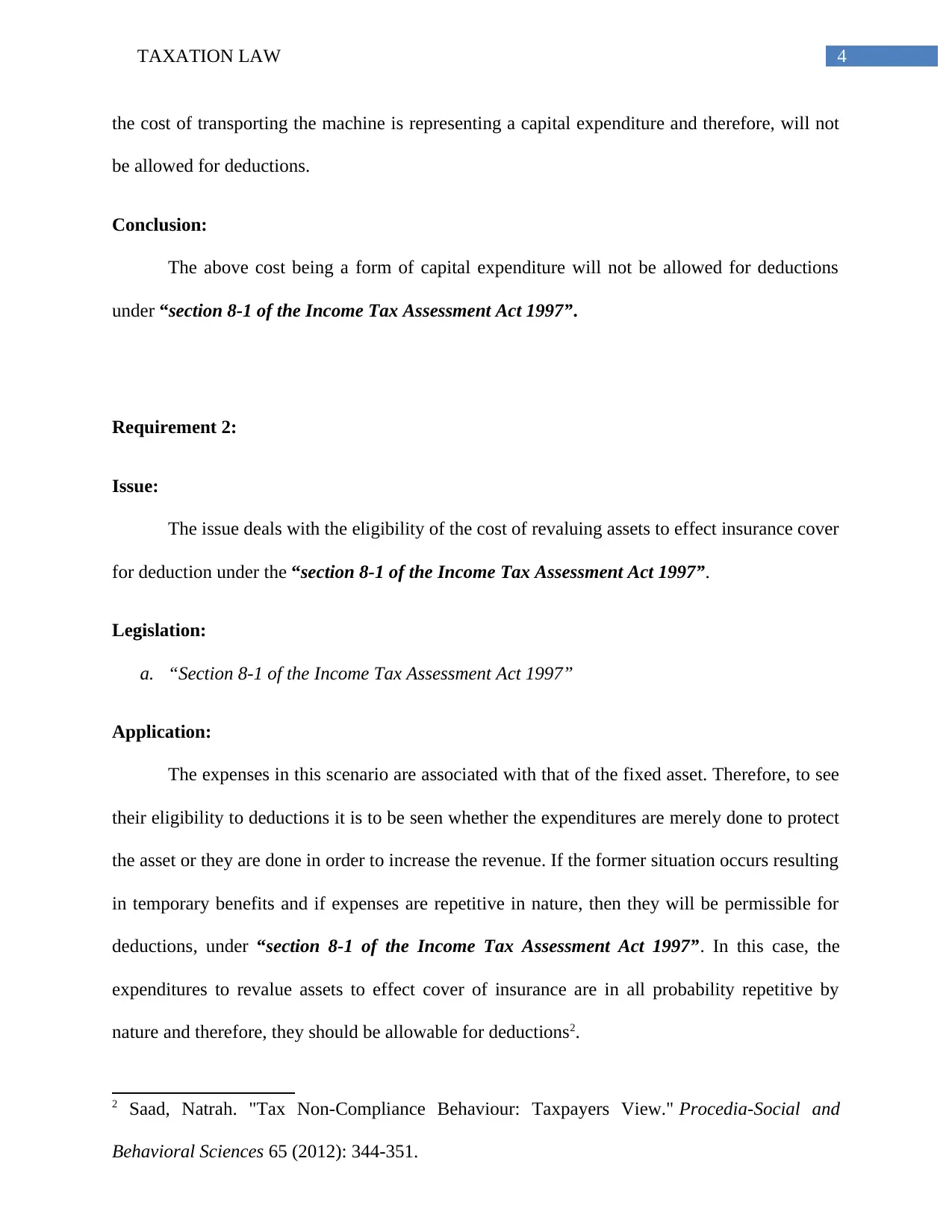
4TAXATION LAW
the cost of transporting the machine is representing a capital expenditure and therefore, will not
be allowed for deductions.
Conclusion:
The above cost being a form of capital expenditure will not be allowed for deductions
under “section 8-1 of the Income Tax Assessment Act 1997”.
Requirement 2:
Issue:
The issue deals with the eligibility of the cost of revaluing assets to effect insurance cover
for deduction under the “section 8-1 of the Income Tax Assessment Act 1997”.
Legislation:
a. “Section 8-1 of the Income Tax Assessment Act 1997”
Application:
The expenses in this scenario are associated with that of the fixed asset. Therefore, to see
their eligibility to deductions it is to be seen whether the expenditures are merely done to protect
the asset or they are done in order to increase the revenue. If the former situation occurs resulting
in temporary benefits and if expenses are repetitive in nature, then they will be permissible for
deductions, under “section 8-1 of the Income Tax Assessment Act 1997”. In this case, the
expenditures to revalue assets to effect cover of insurance are in all probability repetitive by
nature and therefore, they should be allowable for deductions2.
2 Saad, Natrah. "Tax Non-Compliance Behaviour: Taxpayers View." Procedia-Social and
Behavioral Sciences 65 (2012): 344-351.
the cost of transporting the machine is representing a capital expenditure and therefore, will not
be allowed for deductions.
Conclusion:
The above cost being a form of capital expenditure will not be allowed for deductions
under “section 8-1 of the Income Tax Assessment Act 1997”.
Requirement 2:
Issue:
The issue deals with the eligibility of the cost of revaluing assets to effect insurance cover
for deduction under the “section 8-1 of the Income Tax Assessment Act 1997”.
Legislation:
a. “Section 8-1 of the Income Tax Assessment Act 1997”
Application:
The expenses in this scenario are associated with that of the fixed asset. Therefore, to see
their eligibility to deductions it is to be seen whether the expenditures are merely done to protect
the asset or they are done in order to increase the revenue. If the former situation occurs resulting
in temporary benefits and if expenses are repetitive in nature, then they will be permissible for
deductions, under “section 8-1 of the Income Tax Assessment Act 1997”. In this case, the
expenditures to revalue assets to effect cover of insurance are in all probability repetitive by
nature and therefore, they should be allowable for deductions2.
2 Saad, Natrah. "Tax Non-Compliance Behaviour: Taxpayers View." Procedia-Social and
Behavioral Sciences 65 (2012): 344-351.
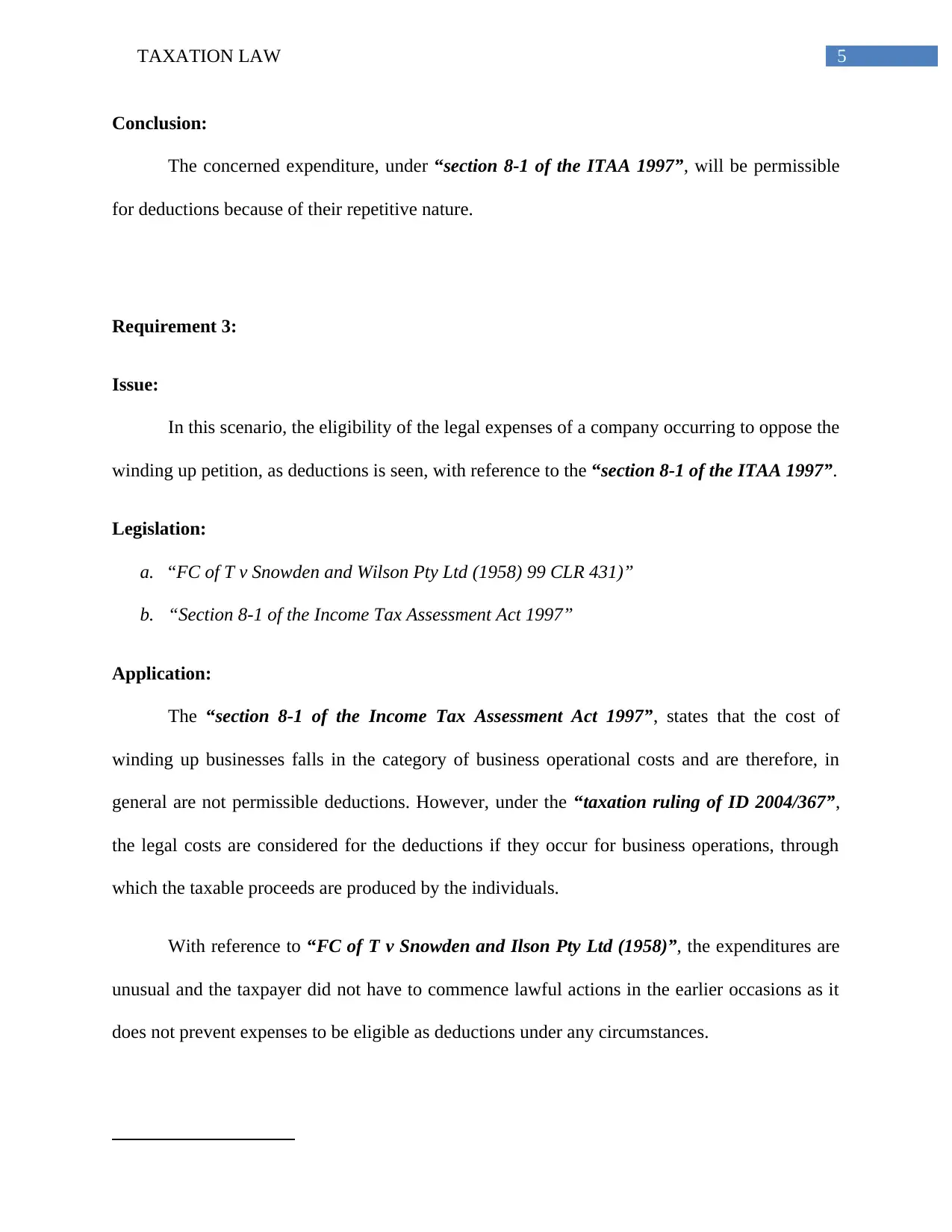
5TAXATION LAW
Conclusion:
The concerned expenditure, under “section 8-1 of the ITAA 1997”, will be permissible
for deductions because of their repetitive nature.
Requirement 3:
Issue:
In this scenario, the eligibility of the legal expenses of a company occurring to oppose the
winding up petition, as deductions is seen, with reference to the “section 8-1 of the ITAA 1997”.
Legislation:
a. “FC of T v Snowden and Wilson Pty Ltd (1958) 99 CLR 431)”
b. “Section 8-1 of the Income Tax Assessment Act 1997”
Application:
The “section 8-1 of the Income Tax Assessment Act 1997”, states that the cost of
winding up businesses falls in the category of business operational costs and are therefore, in
general are not permissible deductions. However, under the “taxation ruling of ID 2004/367”,
the legal costs are considered for the deductions if they occur for business operations, through
which the taxable proceeds are produced by the individuals.
With reference to “FC of T v Snowden and Ilson Pty Ltd (1958)”, the expenditures are
unusual and the taxpayer did not have to commence lawful actions in the earlier occasions as it
does not prevent expenses to be eligible as deductions under any circumstances.
Conclusion:
The concerned expenditure, under “section 8-1 of the ITAA 1997”, will be permissible
for deductions because of their repetitive nature.
Requirement 3:
Issue:
In this scenario, the eligibility of the legal expenses of a company occurring to oppose the
winding up petition, as deductions is seen, with reference to the “section 8-1 of the ITAA 1997”.
Legislation:
a. “FC of T v Snowden and Wilson Pty Ltd (1958) 99 CLR 431)”
b. “Section 8-1 of the Income Tax Assessment Act 1997”
Application:
The “section 8-1 of the Income Tax Assessment Act 1997”, states that the cost of
winding up businesses falls in the category of business operational costs and are therefore, in
general are not permissible deductions. However, under the “taxation ruling of ID 2004/367”,
the legal costs are considered for the deductions if they occur for business operations, through
which the taxable proceeds are produced by the individuals.
With reference to “FC of T v Snowden and Ilson Pty Ltd (1958)”, the expenditures are
unusual and the taxpayer did not have to commence lawful actions in the earlier occasions as it
does not prevent expenses to be eligible as deductions under any circumstances.
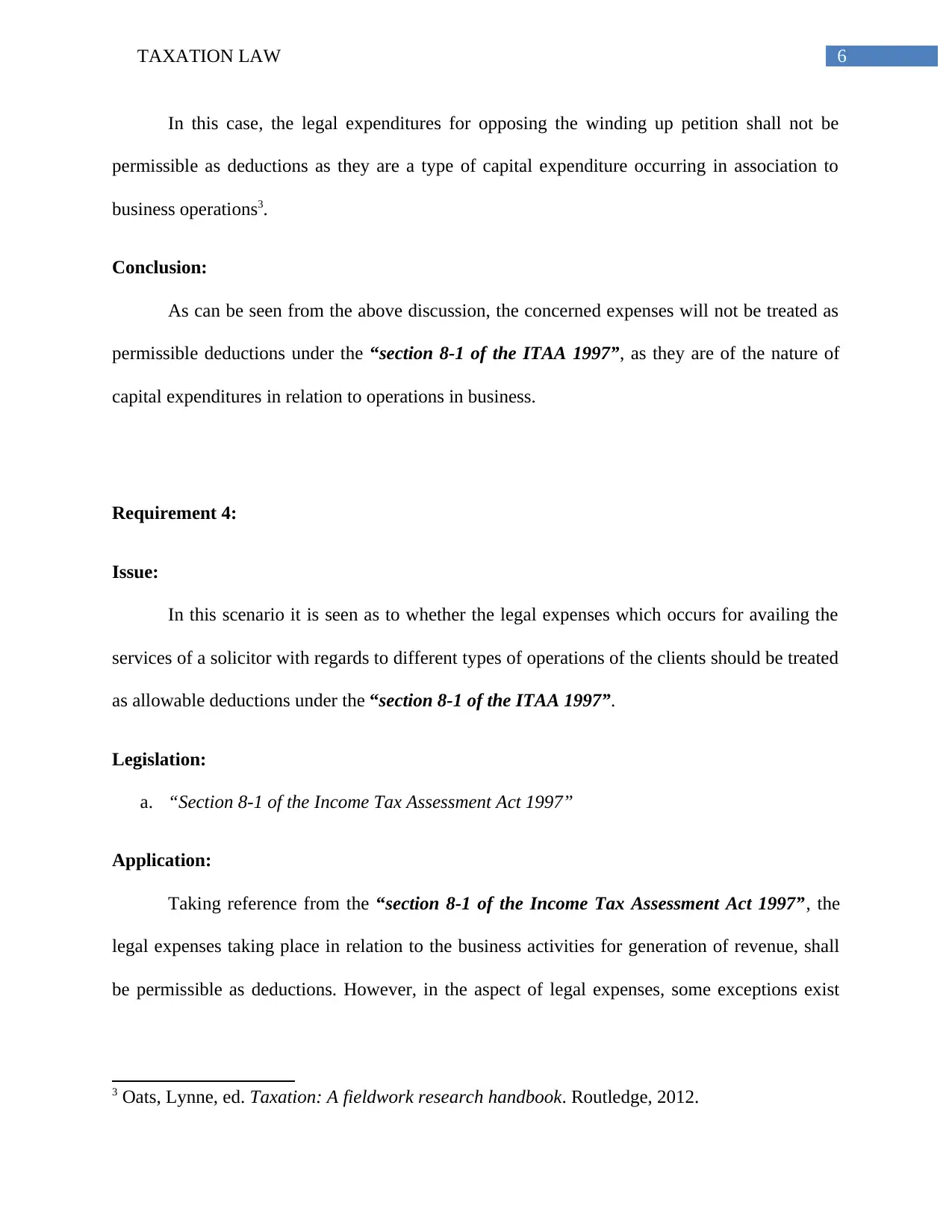
6TAXATION LAW
In this case, the legal expenditures for opposing the winding up petition shall not be
permissible as deductions as they are a type of capital expenditure occurring in association to
business operations3.
Conclusion:
As can be seen from the above discussion, the concerned expenses will not be treated as
permissible deductions under the “section 8-1 of the ITAA 1997”, as they are of the nature of
capital expenditures in relation to operations in business.
Requirement 4:
Issue:
In this scenario it is seen as to whether the legal expenses which occurs for availing the
services of a solicitor with regards to different types of operations of the clients should be treated
as allowable deductions under the “section 8-1 of the ITAA 1997”.
Legislation:
a. “Section 8-1 of the Income Tax Assessment Act 1997”
Application:
Taking reference from the “section 8-1 of the Income Tax Assessment Act 1997”, the
legal expenses taking place in relation to the business activities for generation of revenue, shall
be permissible as deductions. However, in the aspect of legal expenses, some exceptions exist
3 Oats, Lynne, ed. Taxation: A fieldwork research handbook. Routledge, 2012.
In this case, the legal expenditures for opposing the winding up petition shall not be
permissible as deductions as they are a type of capital expenditure occurring in association to
business operations3.
Conclusion:
As can be seen from the above discussion, the concerned expenses will not be treated as
permissible deductions under the “section 8-1 of the ITAA 1997”, as they are of the nature of
capital expenditures in relation to operations in business.
Requirement 4:
Issue:
In this scenario it is seen as to whether the legal expenses which occurs for availing the
services of a solicitor with regards to different types of operations of the clients should be treated
as allowable deductions under the “section 8-1 of the ITAA 1997”.
Legislation:
a. “Section 8-1 of the Income Tax Assessment Act 1997”
Application:
Taking reference from the “section 8-1 of the Income Tax Assessment Act 1997”, the
legal expenses taking place in relation to the business activities for generation of revenue, shall
be permissible as deductions. However, in the aspect of legal expenses, some exceptions exist
3 Oats, Lynne, ed. Taxation: A fieldwork research handbook. Routledge, 2012.
Paraphrase This Document
Need a fresh take? Get an instant paraphrase of this document with our AI Paraphraser
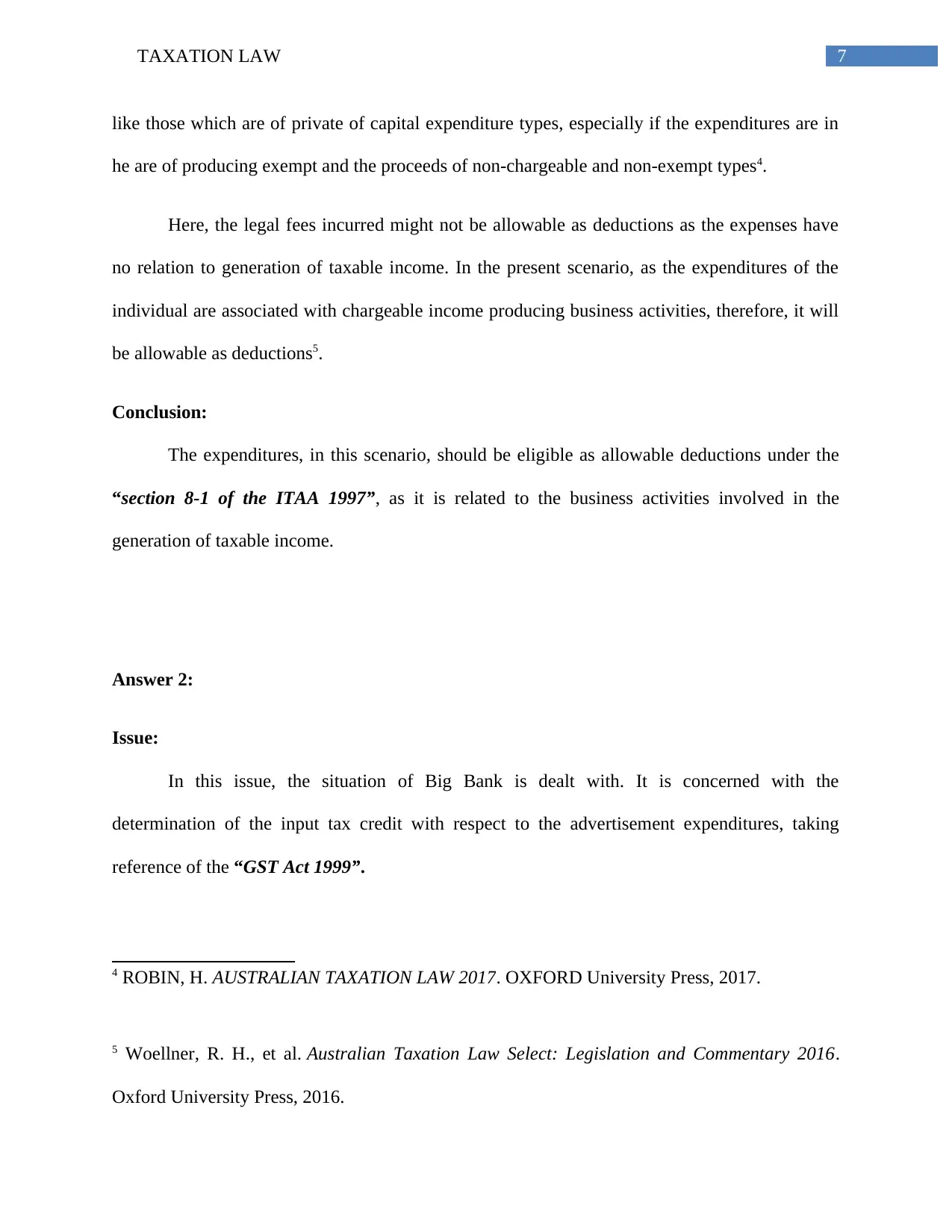
7TAXATION LAW
like those which are of private of capital expenditure types, especially if the expenditures are in
he are of producing exempt and the proceeds of non-chargeable and non-exempt types4.
Here, the legal fees incurred might not be allowable as deductions as the expenses have
no relation to generation of taxable income. In the present scenario, as the expenditures of the
individual are associated with chargeable income producing business activities, therefore, it will
be allowable as deductions5.
Conclusion:
The expenditures, in this scenario, should be eligible as allowable deductions under the
“section 8-1 of the ITAA 1997”, as it is related to the business activities involved in the
generation of taxable income.
Answer 2:
Issue:
In this issue, the situation of Big Bank is dealt with. It is concerned with the
determination of the input tax credit with respect to the advertisement expenditures, taking
reference of the “GST Act 1999”.
4 ROBIN, H. AUSTRALIAN TAXATION LAW 2017. OXFORD University Press, 2017.
5 Woellner, R. H., et al. Australian Taxation Law Select: Legislation and Commentary 2016.
Oxford University Press, 2016.
like those which are of private of capital expenditure types, especially if the expenditures are in
he are of producing exempt and the proceeds of non-chargeable and non-exempt types4.
Here, the legal fees incurred might not be allowable as deductions as the expenses have
no relation to generation of taxable income. In the present scenario, as the expenditures of the
individual are associated with chargeable income producing business activities, therefore, it will
be allowable as deductions5.
Conclusion:
The expenditures, in this scenario, should be eligible as allowable deductions under the
“section 8-1 of the ITAA 1997”, as it is related to the business activities involved in the
generation of taxable income.
Answer 2:
Issue:
In this issue, the situation of Big Bank is dealt with. It is concerned with the
determination of the input tax credit with respect to the advertisement expenditures, taking
reference of the “GST Act 1999”.
4 ROBIN, H. AUSTRALIAN TAXATION LAW 2017. OXFORD University Press, 2017.
5 Woellner, R. H., et al. Australian Taxation Law Select: Legislation and Commentary 2016.
Oxford University Press, 2016.
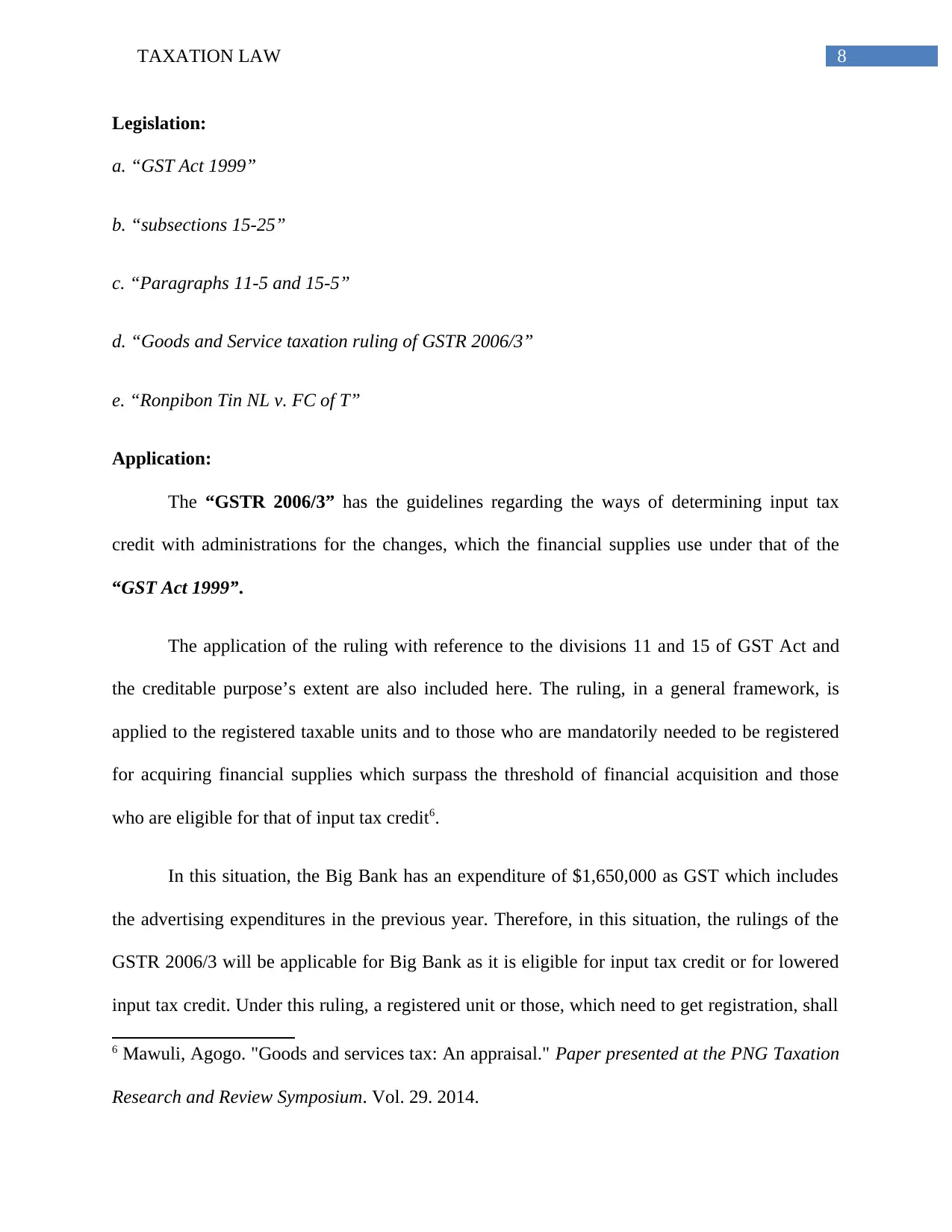
8TAXATION LAW
Legislation:
a. “GST Act 1999”
b. “subsections 15-25”
c. “Paragraphs 11-5 and 15-5”
d. “Goods and Service taxation ruling of GSTR 2006/3”
e. “Ronpibon Tin NL v. FC of T”
Application:
The “GSTR 2006/3” has the guidelines regarding the ways of determining input tax
credit with administrations for the changes, which the financial supplies use under that of the
“GST Act 1999”.
The application of the ruling with reference to the divisions 11 and 15 of GST Act and
the creditable purpose’s extent are also included here. The ruling, in a general framework, is
applied to the registered taxable units and to those who are mandatorily needed to be registered
for acquiring financial supplies which surpass the threshold of financial acquisition and those
who are eligible for that of input tax credit6.
In this situation, the Big Bank has an expenditure of $1,650,000 as GST which includes
the advertising expenditures in the previous year. Therefore, in this situation, the rulings of the
GSTR 2006/3 will be applicable for Big Bank as it is eligible for input tax credit or for lowered
input tax credit. Under this ruling, a registered unit or those, which need to get registration, shall
6 Mawuli, Agogo. "Goods and services tax: An appraisal." Paper presented at the PNG Taxation
Research and Review Symposium. Vol. 29. 2014.
Legislation:
a. “GST Act 1999”
b. “subsections 15-25”
c. “Paragraphs 11-5 and 15-5”
d. “Goods and Service taxation ruling of GSTR 2006/3”
e. “Ronpibon Tin NL v. FC of T”
Application:
The “GSTR 2006/3” has the guidelines regarding the ways of determining input tax
credit with administrations for the changes, which the financial supplies use under that of the
“GST Act 1999”.
The application of the ruling with reference to the divisions 11 and 15 of GST Act and
the creditable purpose’s extent are also included here. The ruling, in a general framework, is
applied to the registered taxable units and to those who are mandatorily needed to be registered
for acquiring financial supplies which surpass the threshold of financial acquisition and those
who are eligible for that of input tax credit6.
In this situation, the Big Bank has an expenditure of $1,650,000 as GST which includes
the advertising expenditures in the previous year. Therefore, in this situation, the rulings of the
GSTR 2006/3 will be applicable for Big Bank as it is eligible for input tax credit or for lowered
input tax credit. Under this ruling, a registered unit or those, which need to get registration, shall
6 Mawuli, Agogo. "Goods and services tax: An appraisal." Paper presented at the PNG Taxation
Research and Review Symposium. Vol. 29. 2014.
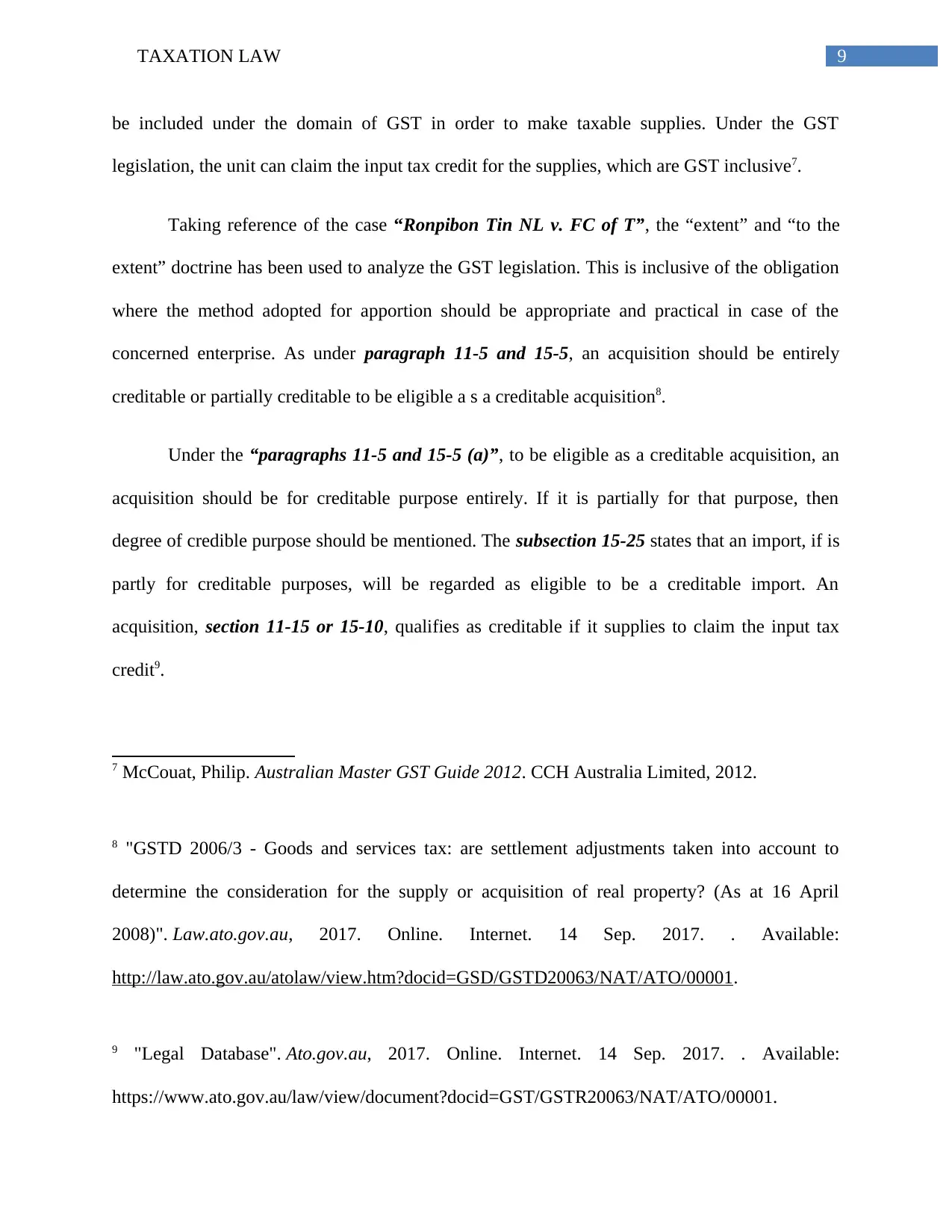
9TAXATION LAW
be included under the domain of GST in order to make taxable supplies. Under the GST
legislation, the unit can claim the input tax credit for the supplies, which are GST inclusive7.
Taking reference of the case “Ronpibon Tin NL v. FC of T”, the “extent” and “to the
extent” doctrine has been used to analyze the GST legislation. This is inclusive of the obligation
where the method adopted for apportion should be appropriate and practical in case of the
concerned enterprise. As under paragraph 11-5 and 15-5, an acquisition should be entirely
creditable or partially creditable to be eligible a s a creditable acquisition8.
Under the “paragraphs 11-5 and 15-5 (a)”, to be eligible as a creditable acquisition, an
acquisition should be for creditable purpose entirely. If it is partially for that purpose, then
degree of credible purpose should be mentioned. The subsection 15-25 states that an import, if is
partly for creditable purposes, will be regarded as eligible to be a creditable import. An
acquisition, section 11-15 or 15-10, qualifies as creditable if it supplies to claim the input tax
credit9.
7 McCouat, Philip. Australian Master GST Guide 2012. CCH Australia Limited, 2012.
8 "GSTD 2006/3 - Goods and services tax: are settlement adjustments taken into account to
determine the consideration for the supply or acquisition of real property? (As at 16 April
2008)". Law.ato.gov.au, 2017. Online. Internet. 14 Sep. 2017. . Available:
http://law.ato.gov.au/atolaw/view.htm?docid=GSD/GSTD20063/NAT/ATO/00001.
9 "Legal Database". Ato.gov.au, 2017. Online. Internet. 14 Sep. 2017. . Available:
https://www.ato.gov.au/law/view/document?docid=GST/GSTR20063/NAT/ATO/00001.
be included under the domain of GST in order to make taxable supplies. Under the GST
legislation, the unit can claim the input tax credit for the supplies, which are GST inclusive7.
Taking reference of the case “Ronpibon Tin NL v. FC of T”, the “extent” and “to the
extent” doctrine has been used to analyze the GST legislation. This is inclusive of the obligation
where the method adopted for apportion should be appropriate and practical in case of the
concerned enterprise. As under paragraph 11-5 and 15-5, an acquisition should be entirely
creditable or partially creditable to be eligible a s a creditable acquisition8.
Under the “paragraphs 11-5 and 15-5 (a)”, to be eligible as a creditable acquisition, an
acquisition should be for creditable purpose entirely. If it is partially for that purpose, then
degree of credible purpose should be mentioned. The subsection 15-25 states that an import, if is
partly for creditable purposes, will be regarded as eligible to be a creditable import. An
acquisition, section 11-15 or 15-10, qualifies as creditable if it supplies to claim the input tax
credit9.
7 McCouat, Philip. Australian Master GST Guide 2012. CCH Australia Limited, 2012.
8 "GSTD 2006/3 - Goods and services tax: are settlement adjustments taken into account to
determine the consideration for the supply or acquisition of real property? (As at 16 April
2008)". Law.ato.gov.au, 2017. Online. Internet. 14 Sep. 2017. . Available:
http://law.ato.gov.au/atolaw/view.htm?docid=GSD/GSTD20063/NAT/ATO/00001.
9 "Legal Database". Ato.gov.au, 2017. Online. Internet. 14 Sep. 2017. . Available:
https://www.ato.gov.au/law/view/document?docid=GST/GSTR20063/NAT/ATO/00001.
Secure Best Marks with AI Grader
Need help grading? Try our AI Grader for instant feedback on your assignments.
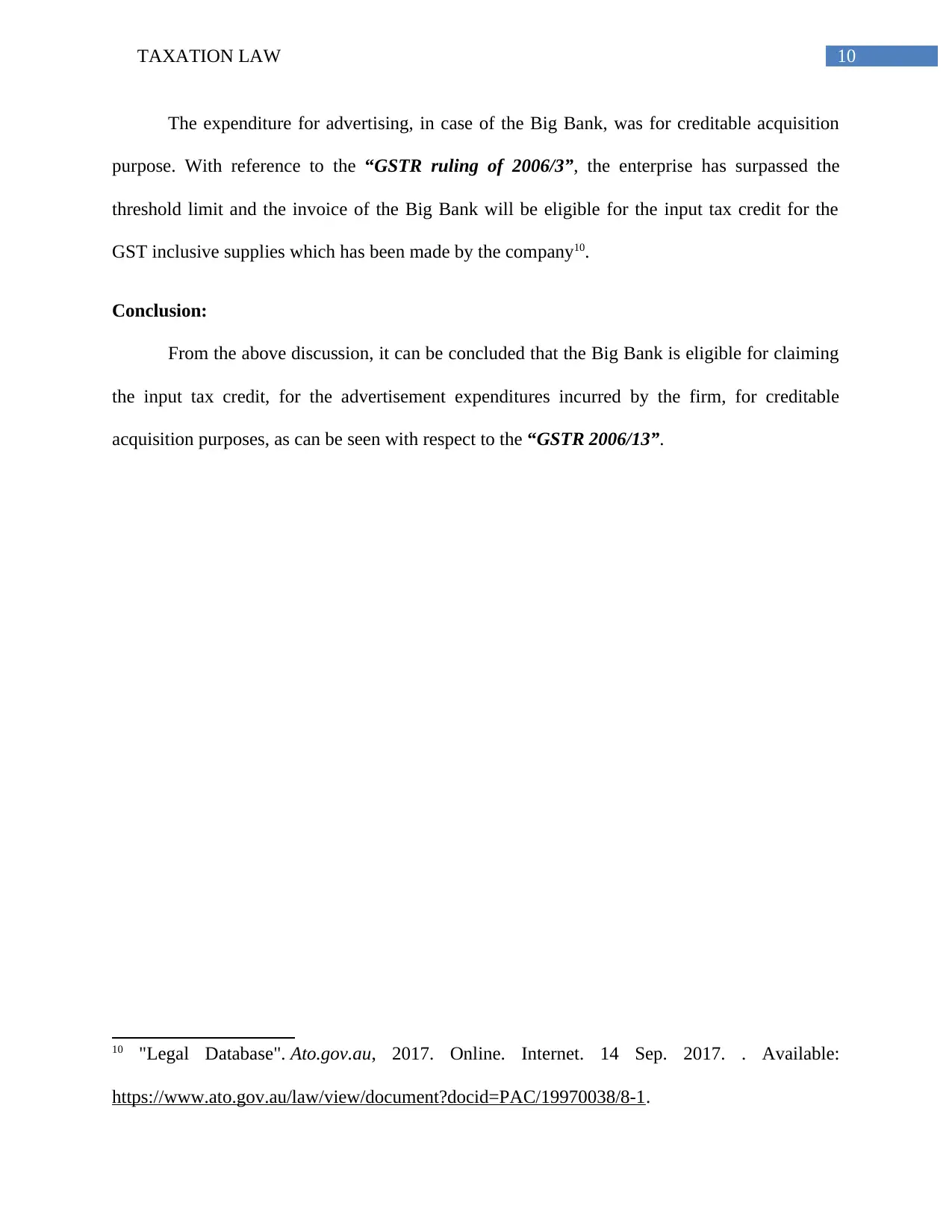
10TAXATION LAW
The expenditure for advertising, in case of the Big Bank, was for creditable acquisition
purpose. With reference to the “GSTR ruling of 2006/3”, the enterprise has surpassed the
threshold limit and the invoice of the Big Bank will be eligible for the input tax credit for the
GST inclusive supplies which has been made by the company10.
Conclusion:
From the above discussion, it can be concluded that the Big Bank is eligible for claiming
the input tax credit, for the advertisement expenditures incurred by the firm, for creditable
acquisition purposes, as can be seen with respect to the “GSTR 2006/13”.
10 "Legal Database". Ato.gov.au, 2017. Online. Internet. 14 Sep. 2017. . Available:
https://www.ato.gov.au/law/view/document?docid=PAC/19970038/8-1.
The expenditure for advertising, in case of the Big Bank, was for creditable acquisition
purpose. With reference to the “GSTR ruling of 2006/3”, the enterprise has surpassed the
threshold limit and the invoice of the Big Bank will be eligible for the input tax credit for the
GST inclusive supplies which has been made by the company10.
Conclusion:
From the above discussion, it can be concluded that the Big Bank is eligible for claiming
the input tax credit, for the advertisement expenditures incurred by the firm, for creditable
acquisition purposes, as can be seen with respect to the “GSTR 2006/13”.
10 "Legal Database". Ato.gov.au, 2017. Online. Internet. 14 Sep. 2017. . Available:
https://www.ato.gov.au/law/view/document?docid=PAC/19970038/8-1.
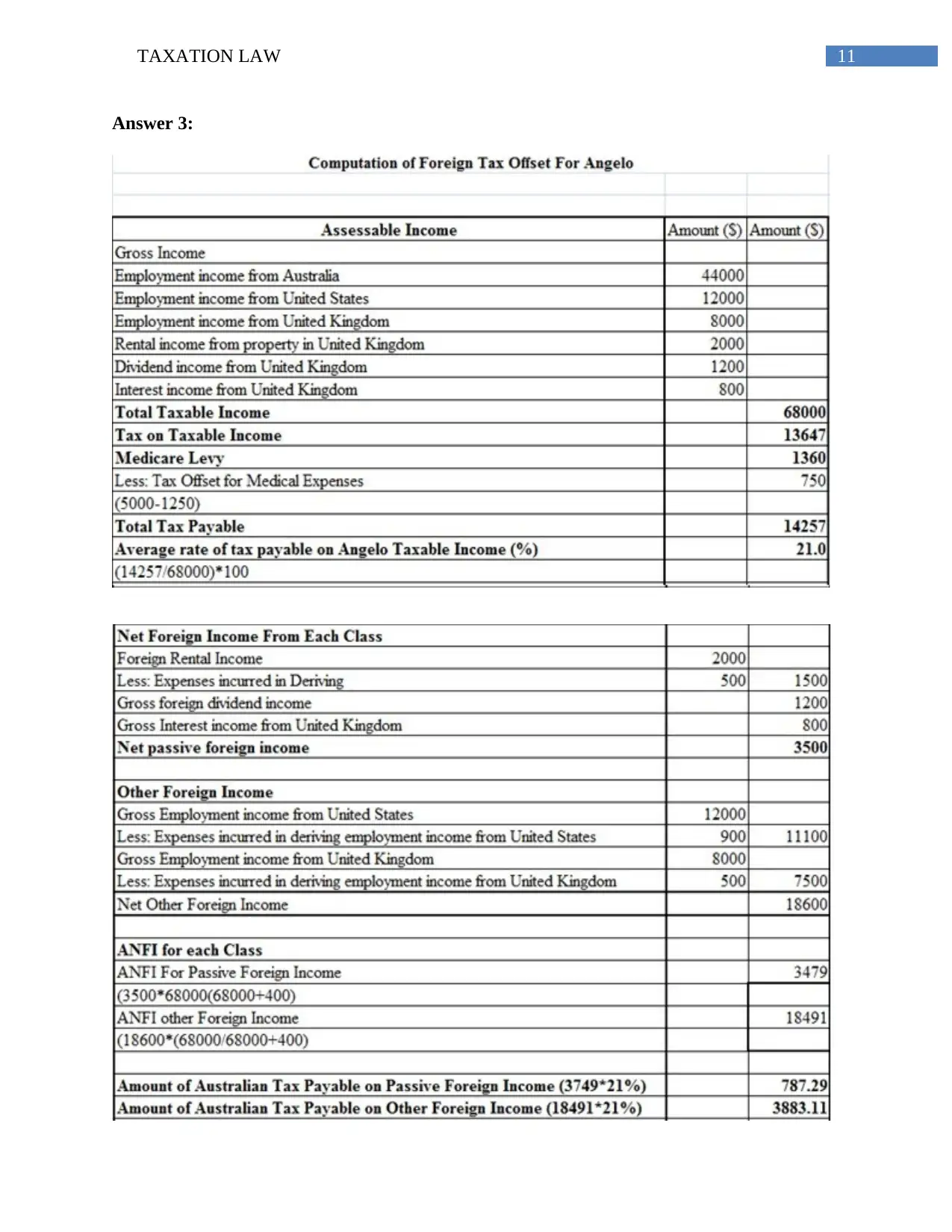
11TAXATION LAW
Answer 3:
Answer 3:
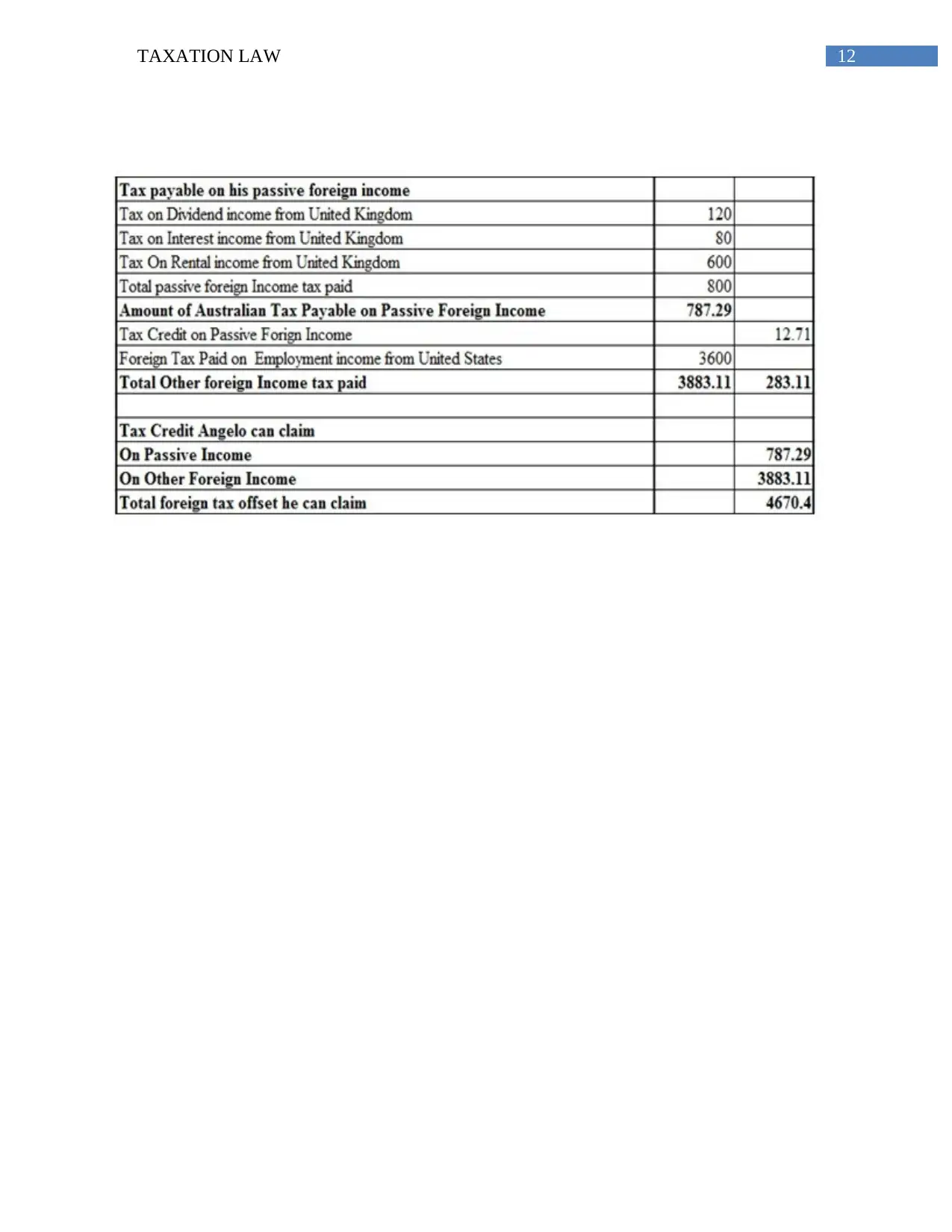
12TAXATION LAW
Paraphrase This Document
Need a fresh take? Get an instant paraphrase of this document with our AI Paraphraser
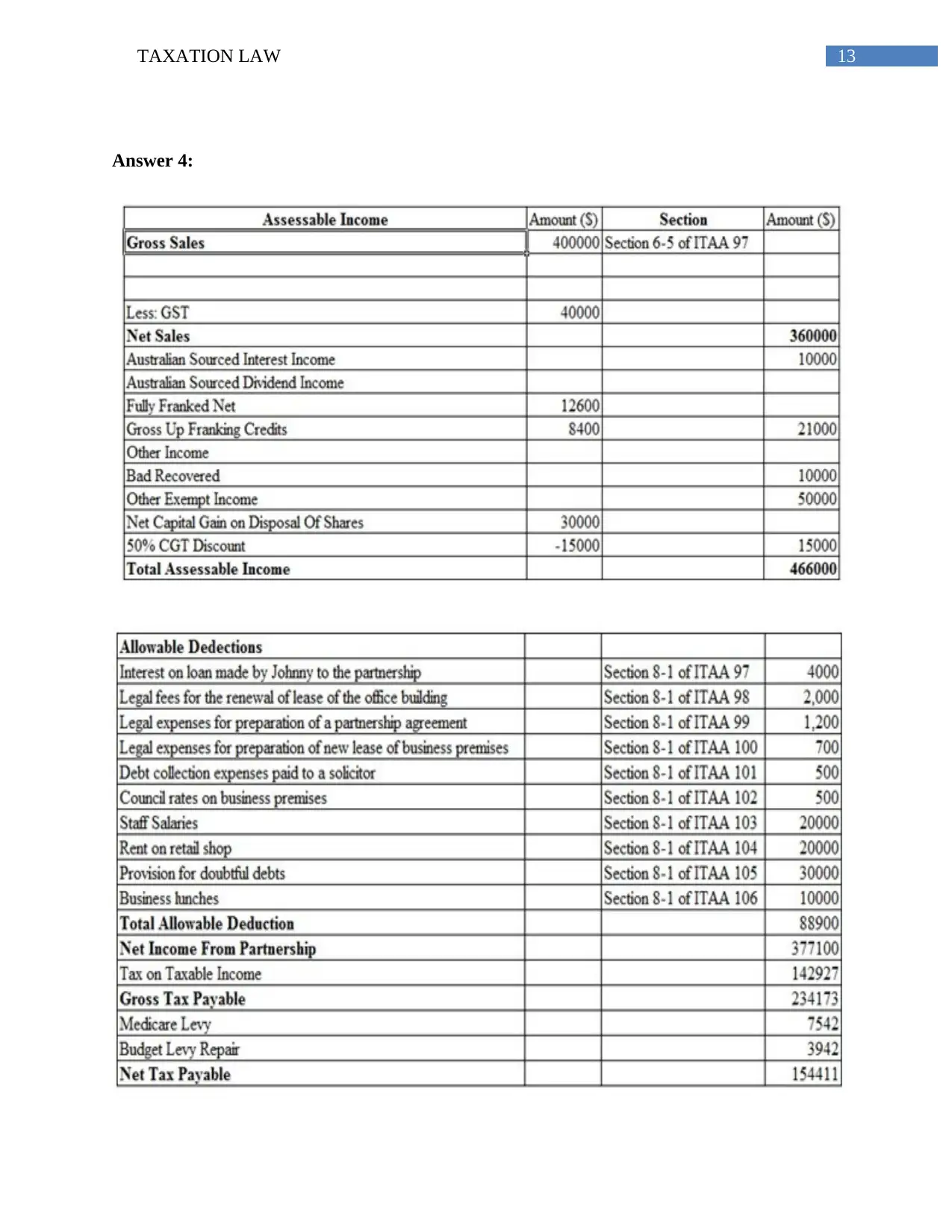
13TAXATION LAW
Answer 4:
Answer 4:
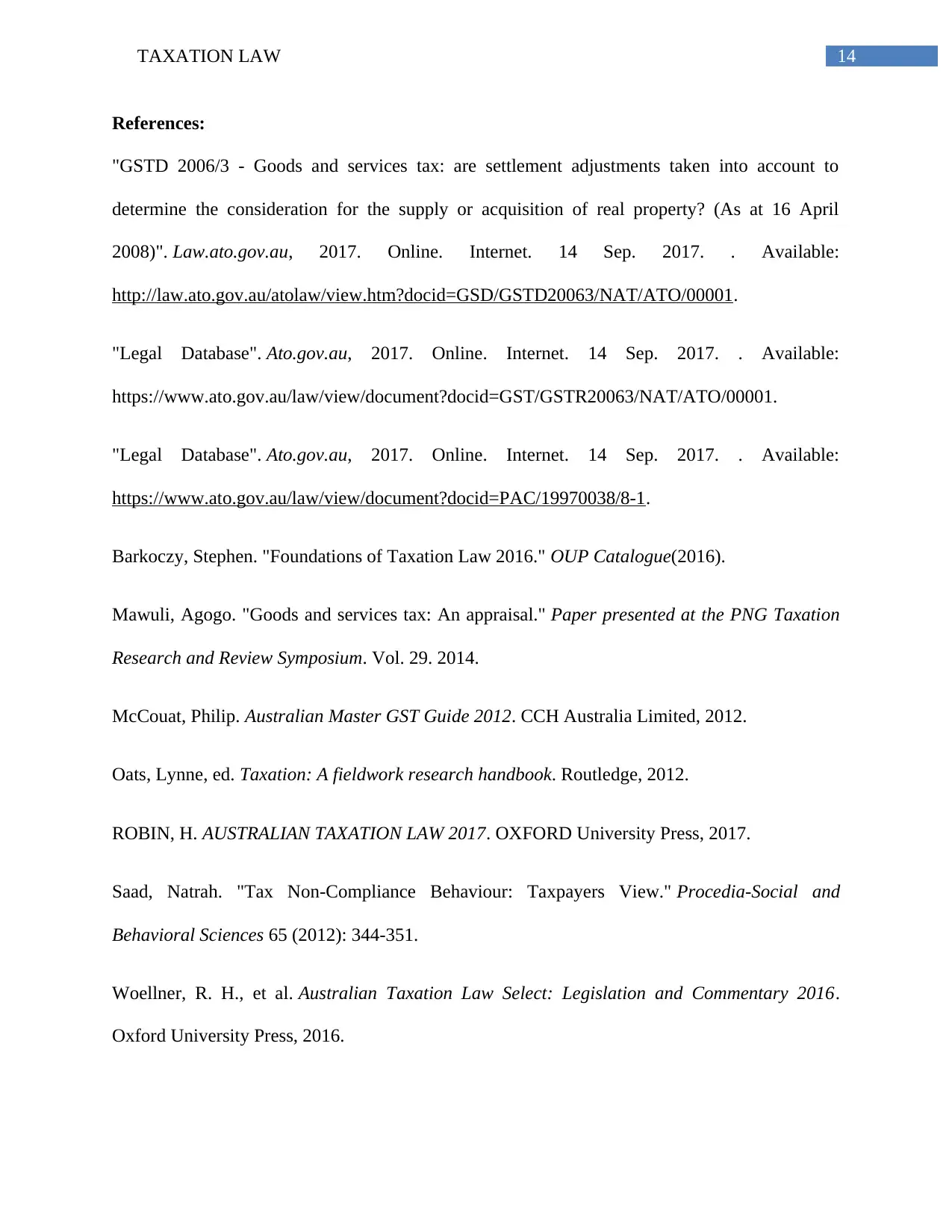
14TAXATION LAW
References:
"GSTD 2006/3 - Goods and services tax: are settlement adjustments taken into account to
determine the consideration for the supply or acquisition of real property? (As at 16 April
2008)". Law.ato.gov.au, 2017. Online. Internet. 14 Sep. 2017. . Available:
http://law.ato.gov.au/atolaw/view.htm?docid=GSD/GSTD20063/NAT/ATO/00001.
"Legal Database". Ato.gov.au, 2017. Online. Internet. 14 Sep. 2017. . Available:
https://www.ato.gov.au/law/view/document?docid=GST/GSTR20063/NAT/ATO/00001.
"Legal Database". Ato.gov.au, 2017. Online. Internet. 14 Sep. 2017. . Available:
https://www.ato.gov.au/law/view/document?docid=PAC/19970038/8-1.
Barkoczy, Stephen. "Foundations of Taxation Law 2016." OUP Catalogue(2016).
Mawuli, Agogo. "Goods and services tax: An appraisal." Paper presented at the PNG Taxation
Research and Review Symposium. Vol. 29. 2014.
McCouat, Philip. Australian Master GST Guide 2012. CCH Australia Limited, 2012.
Oats, Lynne, ed. Taxation: A fieldwork research handbook. Routledge, 2012.
ROBIN, H. AUSTRALIAN TAXATION LAW 2017. OXFORD University Press, 2017.
Saad, Natrah. "Tax Non-Compliance Behaviour: Taxpayers View." Procedia-Social and
Behavioral Sciences 65 (2012): 344-351.
Woellner, R. H., et al. Australian Taxation Law Select: Legislation and Commentary 2016.
Oxford University Press, 2016.
References:
"GSTD 2006/3 - Goods and services tax: are settlement adjustments taken into account to
determine the consideration for the supply or acquisition of real property? (As at 16 April
2008)". Law.ato.gov.au, 2017. Online. Internet. 14 Sep. 2017. . Available:
http://law.ato.gov.au/atolaw/view.htm?docid=GSD/GSTD20063/NAT/ATO/00001.
"Legal Database". Ato.gov.au, 2017. Online. Internet. 14 Sep. 2017. . Available:
https://www.ato.gov.au/law/view/document?docid=GST/GSTR20063/NAT/ATO/00001.
"Legal Database". Ato.gov.au, 2017. Online. Internet. 14 Sep. 2017. . Available:
https://www.ato.gov.au/law/view/document?docid=PAC/19970038/8-1.
Barkoczy, Stephen. "Foundations of Taxation Law 2016." OUP Catalogue(2016).
Mawuli, Agogo. "Goods and services tax: An appraisal." Paper presented at the PNG Taxation
Research and Review Symposium. Vol. 29. 2014.
McCouat, Philip. Australian Master GST Guide 2012. CCH Australia Limited, 2012.
Oats, Lynne, ed. Taxation: A fieldwork research handbook. Routledge, 2012.
ROBIN, H. AUSTRALIAN TAXATION LAW 2017. OXFORD University Press, 2017.
Saad, Natrah. "Tax Non-Compliance Behaviour: Taxpayers View." Procedia-Social and
Behavioral Sciences 65 (2012): 344-351.
Woellner, R. H., et al. Australian Taxation Law Select: Legislation and Commentary 2016.
Oxford University Press, 2016.
1 out of 15
Related Documents
Your All-in-One AI-Powered Toolkit for Academic Success.
+13062052269
info@desklib.com
Available 24*7 on WhatsApp / Email
![[object Object]](/_next/static/media/star-bottom.7253800d.svg)
Unlock your academic potential
© 2024 | Zucol Services PVT LTD | All rights reserved.





